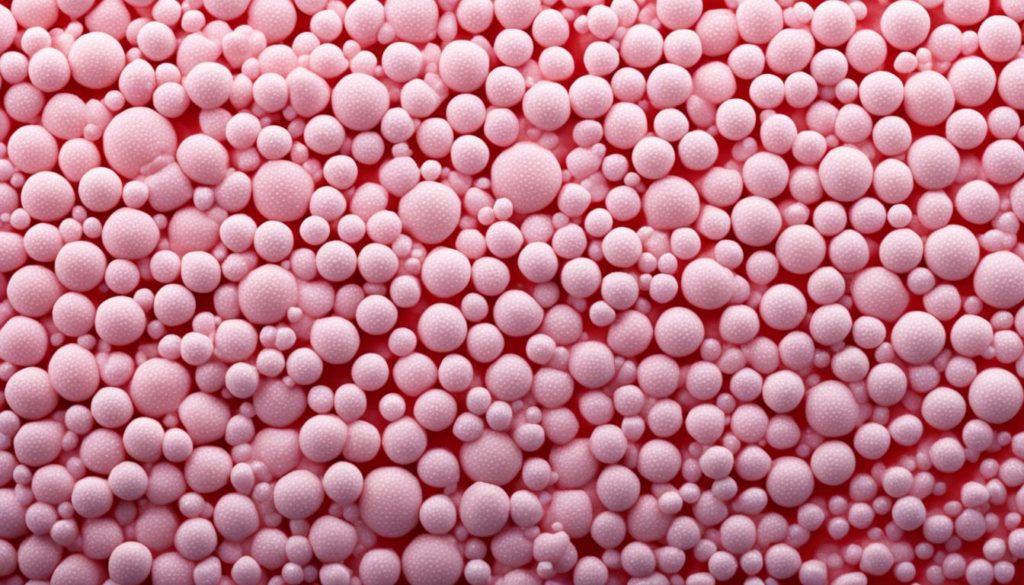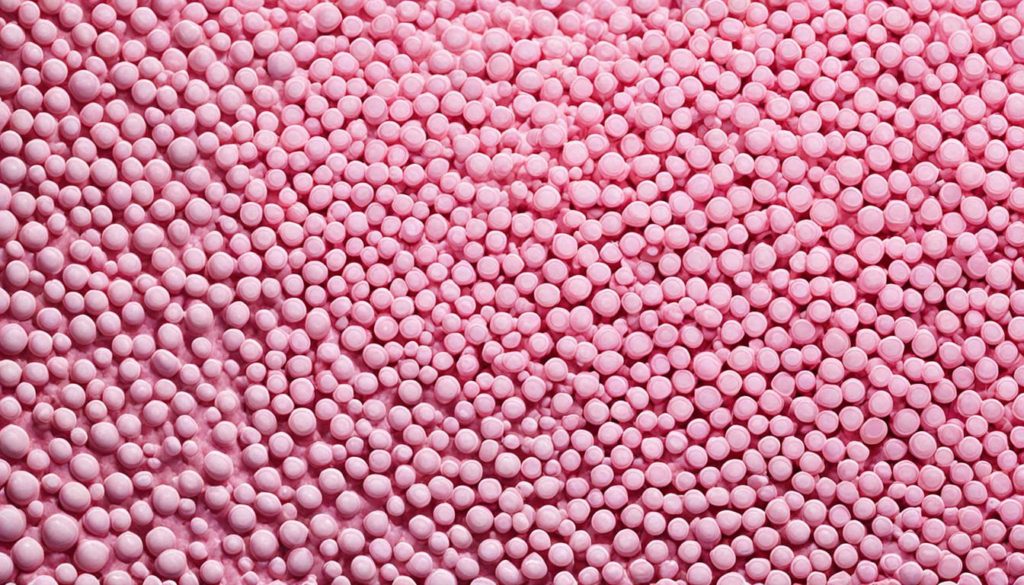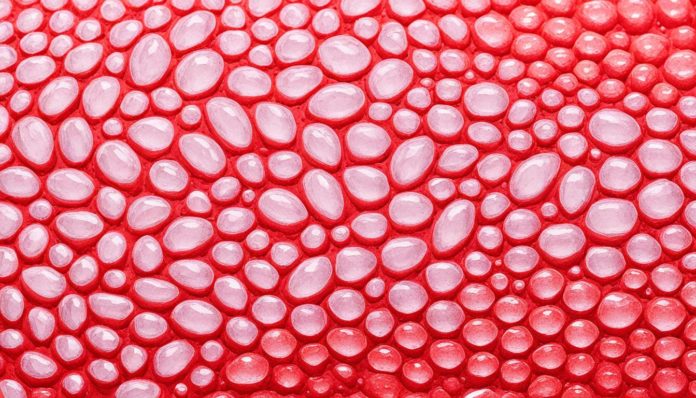Did you know one in every 100 children in the United States has Molluscum Contagiosum? It’s a contagious skin virus that often isn’t spotted. Despite being common, many don’t know how to treat or prevent it. Learning about the cure and treatment can cut down the spread and make those affected feel better.
This article offers deep insights into Molluscum Contagiosum, covering its symptoms, causes, and treatments. Looking for medical advice or home remedies? We’ve gathered all the info you need to handle and prevent this skin issue.
Key Takeaways
- Molluscum Contagiosum is a common contagious skin virus affecting both children and adults.
- Recognizing early symptoms can lead to prompt and effective molluscum treatment.
- Various treatment options are available, from medical to over-the-counter and home remedies.
- Preventive measures, including personal hygiene practices, are crucial in curbing the spread of the virus.
- Special considerations are needed for managing Molluscum Contagiosum in children to ensure child-friendly treatments.
What is Molluscum Contagiosum?
Molluscum Contagiosum is a skin infection caused by the Molluscipoxvirus. It mainly affects the skin’s top layer. The infection leads to small bumps that are white, pink, or skin-colored with a dimple in the middle.

Both children and adults can get Molluscum Contagiosum. It is not usually painful or uncomfortable. Yet, people often worry about how their skin looks because of the bumps.
The poxvirus spreads in the top layer of the skin by using the skin’s cells to multiply. Although it’s contagious, Molluscum Contagiosum is not dangerous. It often goes away on its own in a few months to years.
People catch the infection from direct contact with someone else’s skin or by touching things that have the virus on them. To avoid catching it, it’s important to stay clean and use protective methods.
Knowing about Molluscum Contagiosum can help us handle it better. This ensures it doesn’t affect our daily life or health too much.
Molluscum Contagiosum Symptoms
Molluscum Contagiosum is a skin infection caused by a virus. Catching it early can help manage it better.
Identifying the Early Signs
The early signs of Molluscum can be hard to spot. They start as small, flesh-colored or pinkish bumps that are smooth to the touch. These bumps are about the size of a pinhead or eraser and can pop up anywhere.

Progression of the Virus
The virus might cause more bumps that grow bigger over time. Itching happens, but not often. Sometimes, the bumps can get red and sore as the body fights the virus.
Knowing how it changes can help keep an eye on it and get treatment if needed.
| Early Signs | Progression |
|---|---|
| Small, shiny papules | Increase in number and size |
| Flesh-colored or pinkish | Possible redness and inflammation |
| Painless | Occasional itching |
| Central dimple | Immune system reaction |
Causes and Risk Factors of Molluscum Contagiosum
Molluscum Contagiosum is caused by a poxvirus named molluscum contagiosum virus (MCV). This virus creates small, raised, flesh-colored bumps on the skin. Knowing the causes of Molluscum and Molluscum contagiosum risk factors is crucial for its prevention and control.
How the Virus Spreads
It primarily spreads through skin-to-skin transmission when you’re close to someone. This includes sexual contact. It also spreads by touching things like towels, clothes, and surfaces that have the virus on them.
Even though the bumps aren’t very painful, they’re highly contagious. It’s important to keep clean and not share personal items to avoid spreading the virus.
At-Risk Populations
Some groups are more at risk of getting Molluscum Contagiosum. These groups are:
- Children: They often get close to each other in places like schools and playgrounds, making them more at risk.
- Individuals with weakened immune systems: Those with health issues that affect the immune system, like HIV/AIDS, or those getting cancer treatment might get severe outbreaks.
- Athletes: Sports that require a lot of contact, like wrestling and gymnastics, can lead to more cases of the virus spreading through skin-to-skin transmission.
| Risk Factors | Description |
|---|---|
| Children | Higher exposure due to school and play environments |
| Weakened immune systems | Difficulty in fighting off infections effectively |
| Athletes in contact sports | Increased risk due to direct contact and shared equipment |
| Sexually active adults | Transmission through close physical intimacy |
By understanding and acting on the Molluscum contagiosum risk factors, we can better manage and reduce the spread of this virus, especially among vulnerable groups.
Effective Molluscum Contagiosum Treatments
There are many ways to treat Molluscum Contagiosum. You can choose from medical treatments or over-the-counter options. Knowing your choices helps you deal with symptoms better.
Medical Treatments
Doctors often suggest specific treatments for Molluscum Contagiosum. Let’s look at what they recommend:
- Prescription medications: Your doctor might give you creams or pills. These can fight off the virus with special ingredients.
- Surgical procedures: If your case is tough, a dermatologist might scrape or freeze the spots off.
Over-the-Counter Options
Looking for a way to treat it at home? There are easy-to-use, effective options available. These can help you handle the condition on your own.
| Remedy Type | Benefits |
|---|---|
| Salicylic acid | It takes off the top layer of skin, getting rid of infected areas. |
| Tea tree oil | This has antiviral properties, stopping the virus from spreading. |
| Benzoyl peroxide | It’s an antimicrobial agent, great for fighting skin infections. |
It’s a good idea to talk to a doctor, but these over-the-counter remedies can be a big help too.
Molluscum Contagiosum Home Remedies
Looking for home remedies for molluscum is key for those preferring natural options over medical ones. Here are some effective natural oils, herbal treatments, and skin care tips. They help manage and prevent Molluscum Contagiosum.
Natural Oils and Extracts
Using natural oils and extracts can be quite effective in treating natural Molluscum. These remedies use the healing powers of plants and herbs:
- Tea Tree Oil: With antiviral and antiseptic benefits, diluted tea tree oil applied twice daily can cut down the infection.
- Coconut Oil: Its moisturizing benefits soothe irritated skin, stopping the virus from spreading further.
- Neem Oil: A traditional medicine, neem oil has powerful antiviral effects when applied to the skin lesions.
Herbal Treatments
Herbal treatments are promising for Molluscum Contagiosum management. These herbs are celebrated for their healing powers.
- Echinacea: It strengthens the immune system to combat the virus more efficiently.
- Oregano Oil: It’s packed with antiviral properties that lessen infection severity.
- Calendula: This natural anti-inflammatory is used topically to alleviate swelling and aid healing.
Preventative Skin Care
Preventative skin care is vital to lower Molluscum Contagiosum risks. Here are key measures to implement:
- Good Hygiene: Washing hands regularly and cleaning the affected area can greatly reduce spread chances.
- Avoid Sharing Personal Items: Avoid sharing towels, clothes, and razors to restrict virus transmission.
- Healthy Skincare Habits: Regular moisturizing and avoiding skin harm can keep skin healthy and infection-free.
Professional Medical Treatments for Molluscum Contagiosum
When it comes to molluscum contagiosum, seeking professional help is key. You should see a board-certified dermatologist for correct diagnosis and treatment plan. Various medical treatments are available. They aim to safely get rid of the virus.
Cryotherapy
Cryotherapy for molluscum involves using liquid nitrogen. This substance freezes the lesions. The skin cells then die and the lesions fall off. Though it might be a bit uncomfortable, it’s very effective and has few side effects. Most patients find that their skin clears up quickly after this treatment.
Laser Treatment
Laser therapy for skin virus infections is another strong choice. It uses Pulsed Dye Laser (PDL) to precisely hit the viral lesions. This method promotes fast healing and saves the nearby skin from damage. It’s great for treating multiple or big lesions and provides quicker results than some alternatives.
Knowing about each treatment helps in making wise choices. Let’s compare cryotherapy and laser therapy:
| Treatment Method | Procedure | Benefits | Potential Side Effects |
|---|---|---|---|
| Cryotherapy | Freezing lesions with liquid nitrogen | Quick and effective, minimal side effects | Pain, blistering, temporary redness |
| Laser Therapy | Using Pulsed Dye Laser to target lesions | Precise, rapid healing, minimal tissue damage | Temporary pigmentation changes, slight discomfort |
Managing Molluscum Contagiosum in Children
When dealing with Molluscum contagiosum in children, careful action is needed. This section highlights how to spot symptoms in young ones. It also shares the best, kid-friendly treatments we know.
Symptoms in Children
Finding Molluscum contagiosum in children early is key to help them fast. Look out for:
- Small, painless bumps on the skin
- Bumps with a central dimple, looking pearly or skin-colored
- Lesions may turn red and inflame if scratched
Keep an eye on these signs and see a doctor if you think it’s molluscum contagiosum.
Child-Friendly Treatments
Choosing pediatric molluscum treatment means finding safe yet effective options. Here are some top choices:
| Method | Description | Considerations |
|---|---|---|
| Topical Medications | Creams with salicylic acid or tretinoin | Good for small outbreaks; might slightly irritate |
| Home Remedies | Natural oils like tea tree oil | Easy on skin; needs regular use |
| Cryotherapy | Freezing bumps with liquid nitrogen | Done by doctors; fairly comfortable |
Doctors usually suggest watching and waiting, to ensure treatments don’t upset the child.
Prevention Strategies for Molluscum Contagiosum
To stop Molluscum Contagiosum from spreading, it’s vital to practice good hygiene. This includes washing your hands well and keeping objects clean. Since the virus spreads through skin contact and touching items others use, cleanliness is key. Find more prevention tips at Mayo Clinic.
Personal Hygiene Practices
Lowering your risk means washing hands often with soap and water. This is especially true after touching any sores. It’s also important not to share things like towels, clothes, or razors. Keeping sores covered with bandages can stop the virus from spreading to others.
Preventing Spread in Schools and Public Places
In places like schools, stopping the spread of molluscum is critical. Teaching kids not to scratch and to wash their hands helps a lot. Health experts also say infected people should skip pools and gyms until they’re better. This prevents the virus from spreading through contact.
By everyone doing their part, we can control the virus spread better. Following these suggestions from health experts makes everyone’s efforts more successful. It’s about taking care of yourself and helping protect our communities.
FAQ
What is Molluscum Contagiosum?
Molluscum Contagiosum is a skin infection caused by a virus. It leads to the appearance of unique bumps on the skin.
How is Molluscum Contagiosum spread?
It spreads by direct contact or using items like towels that are not clean. Staying clean helps in preventing it.
What are the early signs of Molluscum Contagiosum?
Early signs include small, painless bumps that may be shiny. They can grow anywhere on the body and might spread.
Who is at risk of contracting Molluscum Contagiosum?
Kids, people with weak immune systems, and contact sports players face higher risks. It’s also common in warm, moist places.
What treatments are available for Molluscum Contagiosum?
There are treatments like medicines, freezing therapy, and lasers. Over-the-counter and home remedies are options too.
Are there any home remedies for Molluscum Contagiosum?
Yes, using natural oils, herbal treatments, and skin care can help. These methods manage symptoms and stop the virus from spreading.
How can I prevent the spread of Molluscum Contagiosum?
To stop the spread, keep clean, don’t share personal items, and avoid touching those infected. Be extra careful in places like schools.
What symptoms should I look for in children?
Look for small, raised bumps that may be shiny. They’re often seen on the face, trunk, and limbs of kids.
What are child-friendly treatments for Molluscum Contagiosum?
For kids, there are gentle treatments like creams and mild freezing. Always check with a pediatrician for the best treatment.


